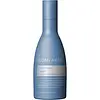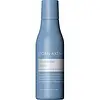What's inside
What's inside
 Benefits
Benefits

 Concerns
Concerns

 Ingredients Side-by-side
Ingredients Side-by-side

Water
Skin ConditioningCetearyl Alcohol
EmollientBehentrimonium Chloride
PreservativePropylene Glycol
HumectantGlyceryl Stearate
EmollientPhenoxyethanol
PreservativeDioleoylethyl Hydroxyethylmonium Methosulfate
Ethylhexyl Stearate
EmollientDimethicone
EmollientGlycereth-2 Cocoate
EmulsifyingHydroxypropyl Guar
Emulsion StabilisingParfum
MaskingIsopropyl Alcohol
SolventArgania Spinosa Kernel Oil
EmollientButylene Glycol
HumectantBenzoic Acid
MaskingDehydroacetic Acid
PreservativeSodium Hydroxide
BufferingHydrolyzed Rhodophyceae Extract
Limonium Gerberi Extract
Skin ProtectingWater, Cetearyl Alcohol, Behentrimonium Chloride, Propylene Glycol, Glyceryl Stearate, Phenoxyethanol, Dioleoylethyl Hydroxyethylmonium Methosulfate, Ethylhexyl Stearate, Dimethicone, Glycereth-2 Cocoate, Hydroxypropyl Guar, Parfum, Isopropyl Alcohol, Argania Spinosa Kernel Oil, Butylene Glycol, Benzoic Acid, Dehydroacetic Acid, Sodium Hydroxide, Hydrolyzed Rhodophyceae Extract, Limonium Gerberi Extract
Water
Skin ConditioningCetearyl Alcohol
EmollientPropylene Glycol
HumectantBehentrimonium Chloride
PreservativeDimethicone
EmollientDioleoylethyl Hydroxyethylmonium Methosulfate
Argania Spinosa Kernel Oil
EmollientCaprylic/Capric Triglyceride
MaskingLimonium Gerberi Extract
Skin ProtectingHydrolyzed Rhodophyceae Extract
Hydroxypropyl Guar
Emulsion StabilisingCetearyl Ethylhexanoate
EmollientGlycereth-2 Cocoate
EmulsifyingParfum
MaskingPhenoxyethanol
PreservativeCaprylyl Glycol
EmollientWater, Cetearyl Alcohol, Propylene Glycol, Behentrimonium Chloride, Dimethicone, Dioleoylethyl Hydroxyethylmonium Methosulfate, Argania Spinosa Kernel Oil, Caprylic/Capric Triglyceride, Limonium Gerberi Extract, Hydrolyzed Rhodophyceae Extract, Hydroxypropyl Guar, Cetearyl Ethylhexanoate, Glycereth-2 Cocoate, Parfum, Phenoxyethanol, Caprylyl Glycol
Ingredients Explained
These ingredients are found in both products.
Ingredients higher up in an ingredient list are typically present in a larger amount.
You may know this ingredient as argan oil. Argan Oil has antioxidant, hydrating, and soothing properties.
Studies have shown argan oil can help fight again radical damage from the sun. This makes it effective at preventing hyperpigmentation.
Large amounts of vitamin E found in argan oil helps the skin retain water. Argan oil also contains fatty acids such as linoleic acid, oleic acid, and palmitic acid. It is also a good source of lipids.
Another benefit of argan oil is skin-soothing. It can help reduce inflammation-related skin symptoms.
Argan Oil is effective at regulating sebum production in pores. This can make it effective at treating hormonal acne.
Traditionally, argan oil was used for its antibacterial and antifungal properties. However, argan oil contains fatty acids that may make it not fungal-acne safe.
Argan Trees are native to Morocco.
Learn more about Argania Spinosa Kernel OilThis ingredient is a preservative and often used for it's anti-static properties. You'll most likely see this ingredient in hair conditioners.
It does not cause irritation or sensitization in leave-on products at 1-5%.
Cetearyl alcohol is a mixture of two fatty alcohols: cetyl alcohol and stearyl alcohol. It is mainly used as an emulsifier. Emulsifiers help prevent the separation of oils and products. Due to its composition, it can also be used to thicken a product or help create foam.
Cetearyl alcohol is an emollient. Emollients help soothe and hydrate the skin by trapping moisture.
Studies show Cetearyl alcohol is non-toxic and non-irritating. The FDA allows products labeled "alcohol-free" to have fatty alcohols.
This ingredient is usually derived from plant oils such as palm, vegetable, or coconut oils. There is debate on whether this ingredient will cause acne.
Due to the fatty acid base, this ingredient may not be Malassezia folliculitis safe.
Learn more about Cetearyl AlcoholDimethicone is a type of synthetic silicone created from natural materials such as quartz.
What it does:
Dimethicone comes in different viscosities:
Depending on the viscosity, dimethicone has different properties.
Ingredients lists don't always show which type is used, so we recommend reaching out to the brand if you have questions about the viscosity.
This ingredient is unlikely to cause irritation because it does not get absorbed into skin. However, people with silicone allergies should be careful about using this ingredient.
Note: Dimethicone may contribute to pilling. This is because it is not oil or water soluble, so pilling may occur when layered with products. When mixed with heavy oils in a formula, the outcome is also quite greasy.
Learn more about DimethiconeDioleoylethyl Hydroxyethylmonium Methosulfate is a type of sulfate.
Glycereth-2 Cocoate can be bad for dry skin.
We don't have a description for Hydrolyzed Rhodophyceae Extract yet.
We don't have a description for Hydroxypropyl Guar yet.
We don't have a description for Limonium Gerberi Extract yet.
Parfum is a catch-all term for an ingredient or more that is used to give a scent to products.
Also called "fragrance", this ingredient can be a blend of hundreds of chemicals or plant oils. This means every product with "fragrance" or "parfum" in the ingredients list is a different mixture.
For instance, Habanolide is a proprietary trade name for a specific aroma chemical. When used as a fragrance ingredient in cosmetics, most aroma chemicals fall under the broad labeling category of “FRAGRANCE” or “PARFUM” according to EU and US regulations.
The term 'parfum' or 'fragrance' is not regulated in many countries. In many cases, it is up to the brand to define this term.
For instance, many brands choose to label themselves as "fragrance-free" because they are not using synthetic fragrances. However, their products may still contain ingredients such as essential oils that are considered a fragrance by INCI standards.
One example is Calendula flower extract. Calendula is an essential oil that still imparts a scent or 'fragrance'.
Depending on the blend, the ingredients in the mixture can cause allergies and sensitivities on the skin. Some ingredients that are known EU allergens include linalool and citronellol.
Parfum can also be used to mask or cover an unpleasant scent.
The bottom line is: not all fragrances/parfum/ingredients are created equally. If you are worried about fragrances, we recommend taking a closer look at an ingredient. And of course, we always recommend speaking with a professional.
Learn more about ParfumPhenoxyethanol is a preservative that has germicide, antimicrobial, and aromatic properties. Studies show that phenoxyethanol can prevent microbial growth. By itself, it has a scent that is similar to that of a rose.
It's often used in formulations along with Caprylyl Glycol to preserve the shelf life of products.
Propylene Glycol is an odorless, colorless liquid. As a humectant, it helps skin retain moisture. It also aids in delivering active ingredients.
Another role of this ingredient is preventing a product from melting or freezing. Propylene glycol also adds antimicrobrial properties to a product, elongating product lifespan.
This ingredient is considered an organic alcohol and commonly added into both cosmetics and foods.
Those with sensitive skin or conditions may develop a rash when using this ingredient.
Learn more about Propylene GlycolWater. It's the most common cosmetic ingredient of all. You'll usually see it at the top of ingredient lists, meaning that it makes up the largest part of the product.
So why is it so popular? Water most often acts as a solvent - this means that it helps dissolve other ingredients into the formulation.
You'll also recognize water as that liquid we all need to stay alive. If you see this, drink a glass of water. Stay hydrated!
Learn more about Water